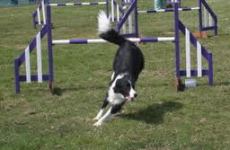How competing my dog illustrated the difference between being capable and being competent.
One of the things I enjoy doing when I’m not working or being Mummy is competing my fabulous Border Collie in Agility competitions. If you aren’t familiar with the sport, it’s basically an obstacle course for dogs. The aim of the game is to get your dog ‘clear’ (i.e. without any mistakes) round all 20 obstacles in the fastest time possible.
Mack (my dog) and I were at the final competition of the season at the weekend. I was watching a friend run her dog round one course and it was a beautiful run. It was fast
and it was faultless. Later in the day, I watched my same friend (with her same dog) run another course and things didn’t go quite as smoothly. This second course had a “wall” jump in it (in addition to the usual pole jumps) and it threw him. He hesitated, then ran round the jump which earned him a refusal. In his bid to please his handler and do his best he then tried to follow her commend to “go on” and took the next pole jump in the line which meant he was eliminated from the course.
My friend was pleased with her dog’s performance; he’d never seen a wall jump after all, so he did his best. However, after watching many other young dogs run the course and take the wall jump effortlessly, she grew curious as to why other dogs weren’t phased by this new (to them) obstacle.
As we chatted about it, it struck me that the difference between the dogs is the difference between being competent and being capable.
Someone who is competent can be described as having the ability to do something successfully or correctly.
Someone who is capable on the other hand is more than that. They can, amongst other things apply their competence in both new and familiar situations.
My friend’s dog is most definitely competent: he can jump a jump, he can weave perfectly, he can stop on the contact piece of the see-saw.
The other dogs, well they were capable. In addition to being able to correctly complete different obstacles, they were also able to take what they already new about jumping and the command for jumping and apply it to a piece of equipment that they hadn’t seen before successfully.
Of course, the dog who won this particular course, was one of the capable ones. They didn’t waste precious seconds hesitating when faced with a new obstacle, they just applied what they already new to a new circumstance.
This conversation got me thinking about how typical learning solutions are teaching people to behave – are we developing competence or capability?
There can be no argument that whilst some specific situations require competence, in general terms we want to develop a workforce which, like the dogs described above, can successfully navigate any obstacle in their path. Not only do capable people apply knowledge successfully in new situations, but they are shown to work well with others, be creative and have a high level of self-efficacy.
However, even with a understanding in the benefits of having capable people, very often we are forced to implement solutions which develop only competence. Manager’s want to know that their staff have been ‘trained’ and are ‘compliant’ – especially where there are legislative risks. But just ticking off a set behaviours that someone can demonstrate successfully isn’t necessarily enough if we don’t also develop the capability of our workforce.
If we just develop competence, we are at risk of stifling creativity and innovation, we may find individuals rely more heavily on their Supervisors/Manager’s and that they don’t feel confident enough to make decisions which in turn slows productivity none of which is good for a successful organisation.
The challenge for us as Learning & Development Professionals is to find implement solutions which develops both capability and competence simultaneously – not an easy task, especially in today’s fast-paced workplaces.
Do you feel you invest enough time in developing workforce capability? If so, what do you do and if not, what are the barriers you face?
How competing my dog illustrated the difference between being capable and being competent.
One of the things I enjoy doing when I’m not working or being Mummy is competing my fabulous Border Collie in Agility competitions. If you aren’t familiar with the sport, it’s basically an obstacle course for dogs. The aim of the game is to get your dog ‘clear’ (i.e. without any mistakes) round all 20 obstacles in the fastest time possible.
Mack (my dog) and I were at the final competition of the season at the weekend. I was watching a friend run her dog round one course and it was a beautiful run. It was fast
and it was faultless. Later in the day, I watched my same friend (with her same dog) run another course and things didn’t go quite as smoothly. This second course had a “wall” jump in it (in addition to the usual pole jumps) and it threw him. He hesitated, then ran round the jump which earned him a refusal. In his bid to please his handler and do his best he then tried to follow her commend to “go on” and took the next pole jump in the line which meant he was eliminated from the course.
My friend was pleased with her dog’s performance; he’d never seen a wall jump after all, so he did his best. However, after watching many other young dogs run the course and take the wall jump effortlessly, she grew curious as to why other dogs weren’t phased by this new (to them) obstacle.
As we chatted about it, it struck me that the difference between the dogs is the difference between being competent and being capable.
Someone who is competent can be described as having the ability to do something successfully or correctly.
Someone who is capable on the other hand is more than that. They can, amongst other things apply their competence in both new and familiar situations.
My friend’s dog is most definitely competent: he can jump a jump, he can weave perfectly, he can stop on the contact piece of the see-saw.
The other dogs, well they were capable. In addition to being able to correctly complete different obstacles, they were also able to take what they already new about jumping and the command for jumping and apply it to a piece of equipment that they hadn’t seen before successfully.
Of course, the dog who won this particular course, was one of the capable ones. They didn’t waste precious seconds hesitating when faced with a new obstacle, they just applied what they already new to a new circumstance.
This conversation got me thinking about how typical learning solutions are teaching people to behave – are we developing competence or capability?
There can be no argument that whilst some specific situations require competence, in general terms we want to develop a workforce which, like the dogs described above, can successfully navigate any obstacle in their path. Not only do capable people apply knowledge successfully in new situations, but they are shown to work well with others, be creative and have a high level of self-efficacy.
However, even with a understanding in the benefits of having capable people, very often we are forced to implement solutions which develop only competence. Manager’s want to know that their staff have been ‘trained’ and are ‘compliant’ – especially where there are legislative risks. But just ticking off a set behaviours that someone can demonstrate successfully isn’t necessarily enough if we don’t also develop the capability of our workforce.
If we just develop competence, we are at risk of stifling creativity and innovation, we may find individuals rely more heavily on their Supervisors/Manager’s and that they don’t feel confident enough to make decisions which in turn slows productivity none of which is good for a successful organisation.
The challenge for us as Learning & Development Professionals is to find implement solutions which develops both capability and competence simultaneously – not an easy task, especially in today’s fast-paced workplaces.
Do you feel you invest enough time in developing workforce capability? If so, what do you do and if not, what are the barriers you face?






